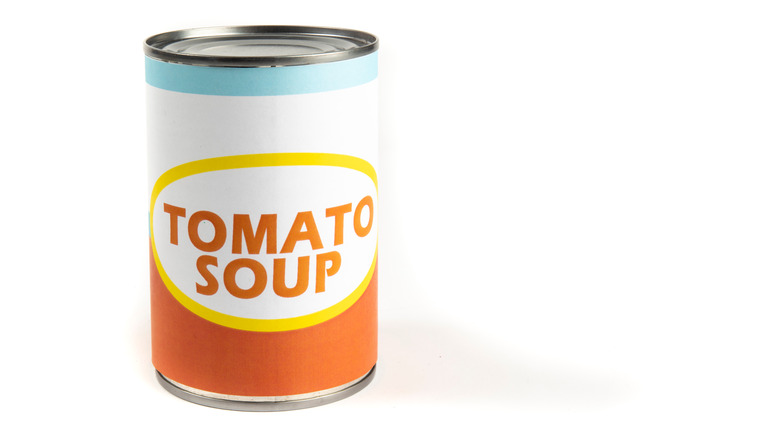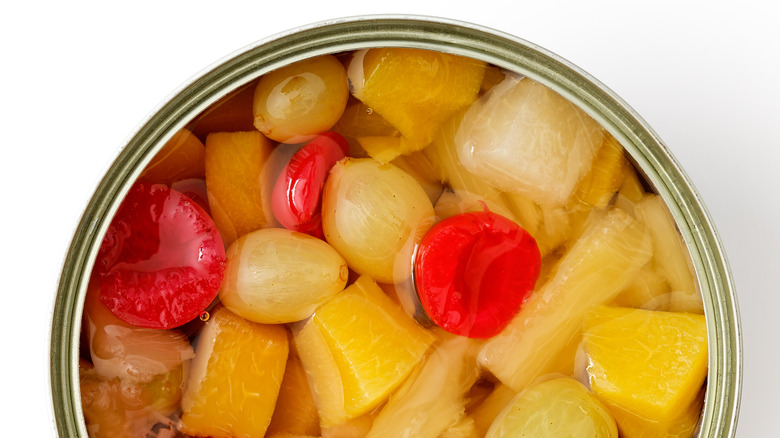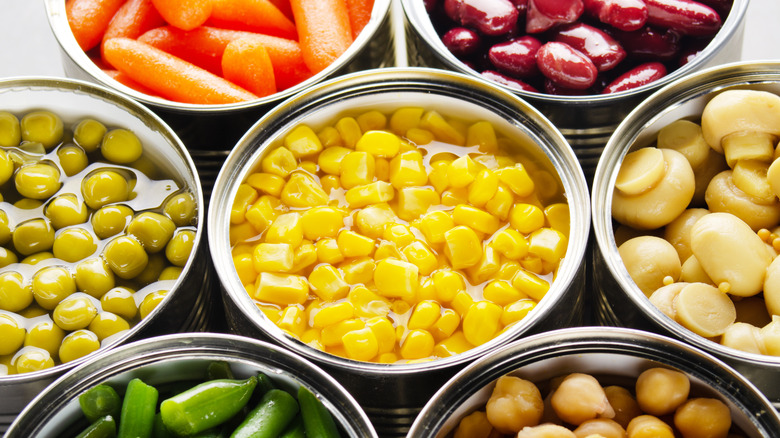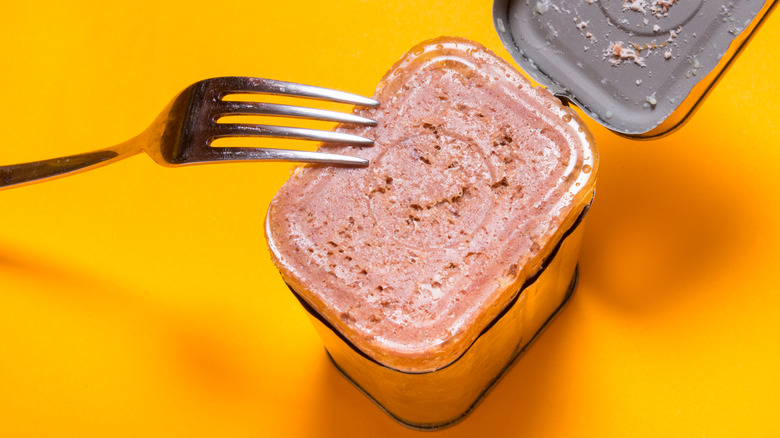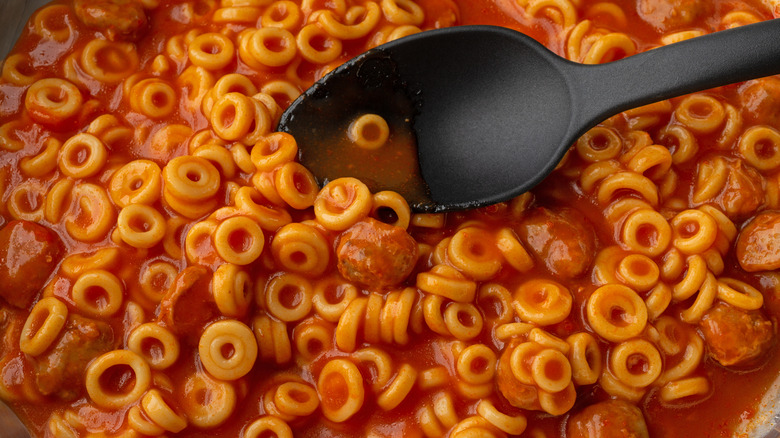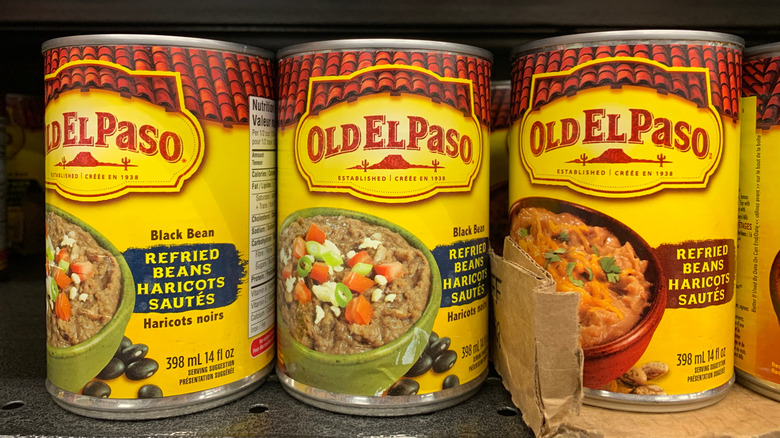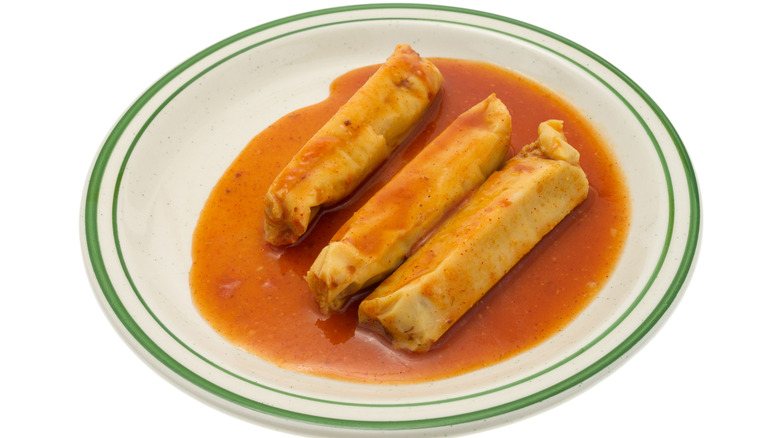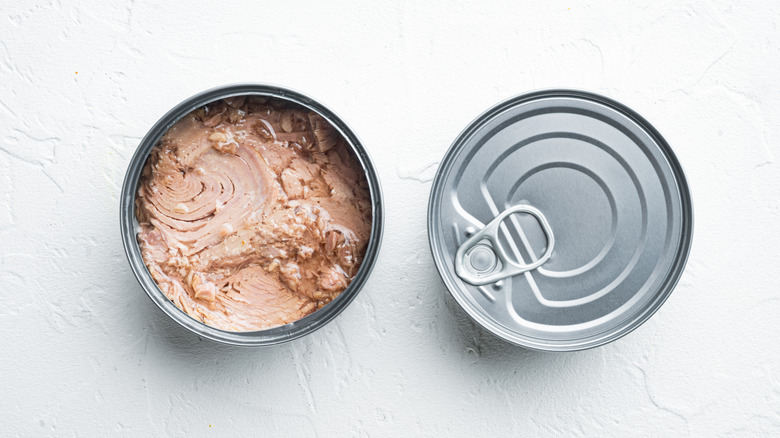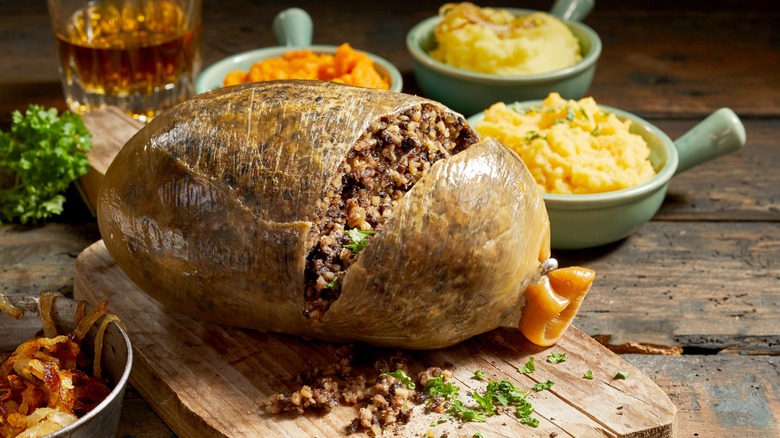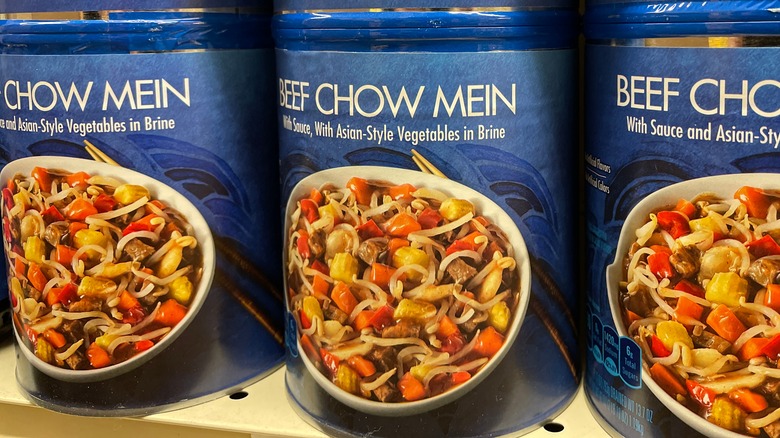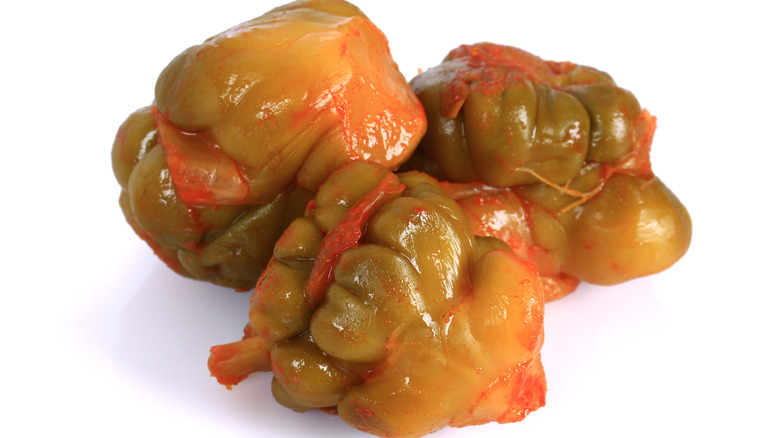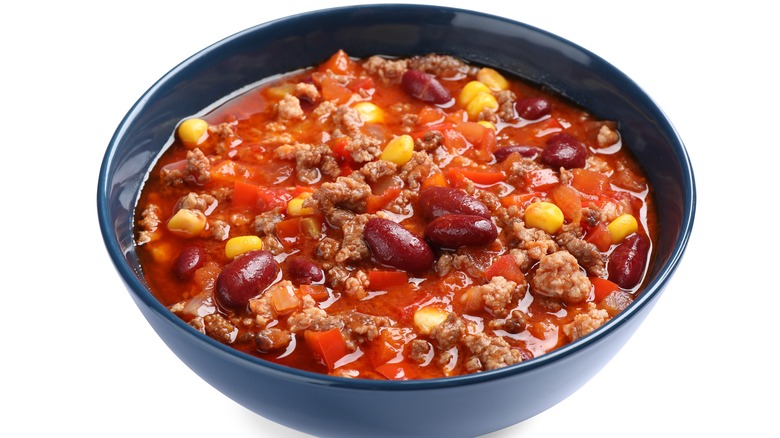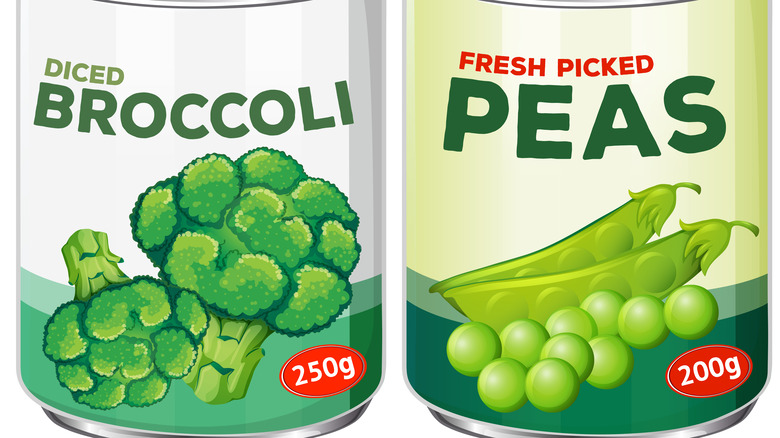16 Worst Canned Foods You Can Buy
We may receive a commission on purchases made from links.
Convenient, affordable, and in many cases, tasty and healthy, there's plenty to love about canned food. Its history can be traced back to the 18th century when the French fought wars in Europe and the Caribbean (via History). Pioneered by Nicolas Appert, the French chef started experimenting by preserving food like fruit, meat, fish, and dairy in sealed champagne bottles and glass containers. By 1804, his factory jumped into the world of tin cans, proving that those that didn't swell after months of storage were safe for selling. By the next century, canned food meant that the armies fighting battles in the US Civil War and the Franco-Prussian War had access to long-lasting food that was also safe to eat.
Over the years, the development of refrigerating and freezing technologies and microwaves has allowed us to store and cook food in several other convenient ways. However, an issue to consider when choosing canned items is the possible presence of BPA (Bisphenol A). These chemicals can have adverse effects on our brain, leading to increased blood pressure, heart disease, and type 2 diabetes, according to the Mayo Clinic. Also, some nutrients, such as water-soluble vitamins like vitamins B and C, can get diluted during the canning process, which affects our nutrient intake.
All things considered, canned food can still be a great part of anyone's food pantry. However, not all canned foods are equal, and here are a few canned items that are best left unopened.
1. Canned soups with high sodium and fat content
Few things are as comforting as a bowl of hot soup. And when it comes to canned soups, few items are as tricky. While some versions are as healthy as they are tasty, many canned soups pose as good-for-you, veggie-packed meals when, in reality, they're chock-full of preservatives and salt, bad news for our heart and kidneys. Fortunately, we've compiled a great list of the worst to best-canned soups to ease your health concerns.
Canned soups can hide dangerous amounts of sodium between their apparent liquid goodness. According to Men's Journal, we should look for soups that contain less than 350 milligrams of sodium. Fat can also be a concern when we're talking about cream-based canned soups, like cream of mushroom or corn, as well as bisques and chowders. A good rule of thumb is to choose soups that contain as few ingredients as possible and at least 5 grams of protein. And when it comes to BPA, studies suggest amounts may be much higher in soups than in other canned foods.
2. Fruit canned in syrup
If an apple a day keeps the doctor away, it's safe to say not all apples come in the same packaging. The first thing to consider is that most fruit is peeled, sliced, or chopped before being cooked and canned. This means that some components, like the fiber and antioxidants in the peels, will get lost in the process. For example, via Healthline, an apple with skin has 332% more vitamin K, 115% more vitamin C, and 19% more potassium than a peeled apple.
The canning process also reduces the amount of water-soluble vitamin C and most vitamin B in fruits (according to Livestrong). At the same time, the presence of carbs and sugar significantly increases when the fruit is canned with heavy syrup. According to Nutrition Value, the average can of fruit cocktail in syrup (250 grams) contains 4.8 milligrams of vitamin C and 40 grams of carbohydrates. In contrast, a homemade, fresh fruit salad (150 grams) has 20 grams of carbohydrates and 39 milligrams of vitamin C.
3. Vegetables canned in brine
Similar to fruit, vegetables can lose some of their nutrients during the canning process, especially water-soluble vitamins like vitamin B and C, when exposed to high heat (via BBC). When vegetables are packed in brine, they can lose their phenolic compounds, which give them their flavor, color, and some of their nutrients (according to Insider), and even more so when they have been skinned or peeled.
Brine can also have a high sodium content, as it is made with water and salt. And while it can give canned veggies, such as corn, asparagus, or hearts of palm, a pleasant and savory taste, it can also spike up our sodium intake. The CDC warns that consuming too much sodium increases the risk of high blood pressure, heart disease, and stroke. Bottom line: it's definitely wise to check the label and look for the canned vegetables with the lowest possible sodium content.
4. Canned corned beef
Made from meat brined in salt and spices, corned beef is a processed meat. While the corned beef you'll find at the deli counter is made from brisket, its canned counterpart is often produced using some cuts that aren't good enough to be sold on the deli counter, according to FoodHow.
Like sausages, bacon, and other meats that fall under the processed meats category, corned beef is considered a potentially carcinogenic food item when consumed in high amounts, increasing the risk for cancer and heart disease.
Interestingly, corned beef has nothing to do with corn; instead, "corned" refers to the rock salt used to preserve the meat. The large pieces of rock salt resemble corn kernels, eventually leading to them to being called salt corns in the 1800s. As you may have guessed, the presence of rock salt means high amounts of sodium, so the possibility of increased blood pressure and heart disease is an issue with corned beef.
5. Canned pre-cooked pasta
At first thought, a can of spaghetti and meatballs might bring warm childhood memories, but these pre-cooked dishes tend to come packed with a ton of unwanted ingredients, many of which are found in the sauce. For example, Chef Boyardee's Spaghetti & Meatballs has 10 grams of sugar due to the high fructose corn syrup in the sauce.
While a homemade tomato sauce is a great source of nutrients, such as vitamins K and C, potassium, and antioxidants (which can reduce the risk of cancer and heart disease), most of these properties will be missing from the pre-made sauce in the canned version (via Healthline). Instead, canned tomato sauce contains added sugars and sodium, which, aside from the aforementioned possible blood pressure and kidney problems, can cause liquid retention. According to Scientific American, people whose diets are high in salt appear to store more body fat, particularly around their midsection.
6. Canned sausages
Sausages are, by definition, processed meats: they've been transformed through processes such as salting, curing, or smoking to improve preservation or improve their flavor. Processed meats have been linked to an increased risk of cancer and diabetes (via WHO). These health issues can be caused by the presence of chemicals called nitrates and nitrites, which can be converted into carcinogens once absorbed by our bodies, as well as by two of the usual culprits: sodium and saturated fats.
According to the American Heart Association, an increased intake of saturated fats can affect our cholesterol levels, putting us at a higher risk of heart disease. Our daily calorie intake should include no more than 5 or 6% calories from saturated fat, but a 130-gram can of Libby's Vienna sausages contains 13 grams of fat, of which 4 grams are saturated fats. When hot dogs or cocktail sausages are on the menu, it's better to choose fresh sausages made with few ingredients or even poultry sausages.
7. Canned refried beans
While beans are an excellent source of protein, vitamins, potassium, and fiber and are considered an all-around, heart-friendly food, there are certainly ways to make them unhealthy (via The Bean Institute). Traditionally, refried beans are mashed pinto beans pan-fried in lard or oil (a healthier choice) and seasoned with onion, garlic, or peppers. Refried beans are also available in cans as a Mexican and Tex-Mex cuisine staple.
The problem with canned refried beans is that they contain undesirable amounts of fat and sodium. The average can of refried beans contains around 3 grams fat and up to 750 milligrams of sodium. Following the American Heart Association guidelines, we should aim to consume no more than 2,300 milligrams of sodium each day, and the number drops to 1,500 milligrams a day for adults with high blood pressure. When shopping for canned refried beans, search for low-sodium options. When it's time to eat them, use them as a side for a healthier dish, such as a grilled piece of chicken or beef, resulting in a more balanced meal.
8. Canned whole chicken
As its name promises, a 50-ounce can of Sweet Sue Chicken Without Giblets literally contains an entire cooked chicken swimming in broth. If served hot, this chicken can be heated in the oven with some broth, reserving the rest to prepare the gravy. The instructions on the can also indicate that the chicken can be served cold, straight from the can.
According to bloggers who have experienced this intriguing canned item, the chicken tends to disintegrate when brought out from the can and also presents a tinny flavor. Although it's low in sodium and some customer reviews on Amazon claim it's useful for preparing a chicken salad or enchilada fillings, we think it's best to go with regular old shredded chicken for those recipes. After all, plenty of Amazon reviews say it's popular as a gag present at office Christmas parties, making this canned food an unappealing item for your food pantry.
9. Canned tamales
In Mexico and other Latin American countries, tamales have been a beloved specialty consumed since pre-Hispanic times. These small, steamed cakes are made with corn-based dough and can contain dozens of different fillings, including meat, fish, cheese, vegetables, and even fruit and raisins. Seasonings also vary from region to region, as do wrappings, which can include corn husks and banana leaves. Recipes are usually tied to family or local traditions, and making tamales takes a lot of time and effort. Many families enjoy them on holidays and, to many, they are the ultimate comfort food (via Cultura Colectiva).
However, their canned counterparts fail to tell such a rich story, and they lack seasoning and texture. Hormel tamales, for example, come individually wrapped in wax paper and are canned in a mild, watery sauce. At 8 grams of fat and 990 milligrams of sodium per serving, they're not exactly nutrition goals, either.
10. Canned white tuna with high mercury levels
Canned tuna is generally healthy and low-calorie, but as it turns out, not all tuna options are equally good for us. When shopping for canned tuna, look out for albacore or white tuna, which includes mercury levels almost three times higher than skipjack tuna, which is used in most light tuna products. Canned white tuna contains 0.32 parts per million of mercury, and the FDA recommends that adults only eat it up to three times a month (this includes pregnant women). As for canned light tuna, it contains 0.12 parts per million of mercury.
While mercury is naturally found in the air, soil, and water, it may have toxic effects on our lungs, kidneys, and eyes, as well as on the digestive, immune, and nervous systems, according to WHO. It's especially dangerous for babies in the womb, so pregnant women should be mindful when consuming canned tuna and fish.
11. Canned haggis
Haggis is the national dish of Scotland, famously celebrated by the country's poet laureate Robert Burns in his "Address to a Haggis." Haggis is, fair to say, something of an acquired taste for the uninitiated. It is a type of pudding consisting of a sheep's "pluck" (as in, its liver, heart, and lungs) minced and mixed with beef or mutton suet, oatmeal, stock, and seasoned with onion and other spices. The mixture is traditionally stuffed into a sheep's stomach, lung, or an edible artificial casing before being boiled. If that does not sound attractive to you, take comfort in the fact that you are not alone. Famed chef Alex Guarnaschelli identifies haggis as one of the two dishes she absolutely refuses to eat.
So, what could be better than haggis in canned form? The simple reality is that canned haggis is one of the few ways you can sample this Scottish treasure in the United States. It is the traditional lungs that are to blame for that: The USDA has banned haggis since 1971 and few American butchers make it.
12. Canned chow mein
Chow mein is a staple of American Chinese cuisine with roots that, not surprisingly, goes back to China and, more particularly, Cantonese cuisine. Chow mein is made with wheat flour and egg noodles that are boiled then stir-fried with a meat element and vegetables like cabbage, onions, or bean sprouts. The sauce is built on soy sauce, sesame oil, pepper flakes, and rice wine. Chow mein is also one of the most popular Chinese dishes in America.
Given the popularity of chow mein in the United States, it should come as no surprise that this takeout classic managed to find its way into cans. The main problem with canned chow mein is that it bears only a cursory resemblance to the real stuff — it's "chow mein" in name only.
Where the real dish is all about a celebration of fresh ingredients cooked just to their peak, canned chow mein is the opposite. The ingredients are either too hard or too soft, with short, brown noodles, rubbery mushrooms, and soft, mushy, and tasteless sprouts. And that's without even getting into whatever that vaguely sauce-like liquid might be. If there is one word to summarize the canned chow mein experience it is this one: bland.
13. Canned Sichuan Preserved Vegetables
Not all prepared products in the various regional Chinese cuisines need to be or even ought to be fresh. In fact, zha cai — Sichuan pickled vegetables — are an essential ingredient in many classic Chinese dishes. Zha Cai is typically a Chinese condiment made from mustard tubers but it can also be referred to (and labeled) variously as "salted spicy radish," "pickled mustard strips," "preserved turnips," "Szechuan preserved vegetables," or any of many other confusing labels.
Most often, these products come in plastic or foil packets or even in little pots. But, it was probably only a matter of time before Sichuan preserved vegetables were given the canned treatment. And, perhaps not surprisingly, the canned version brought something more to the party; specifically, a lot of salt. Take, for example, Lucky Rabbit's canned Szechuan Preserved Vegetables: On the bright side, a 12-ounce can sports only 16 calories. But, those 16 calories deliver 1308 milligrams of sodium. Your cardiologist will be so happy!
By way of comparison, a typical non-canned version will have a lot less sodium. Go with one of those non-canned packets of Sichuan preserved vegetables. Or make your own.
14. Canned chili
We have South Texas to thank for the chili we know today, per Texas Monthly. Combining influences from places as diverse as Mexico and the Canary Islands off Africa, the publication says chili con carne is classically a spicy stew based on chile peppers, meat, and sometimes, controversially, beans. One could be forgiven for thinking that sounds good and wholesome and like ultimate comfort food. And perhaps it is just that, at least so long as it does not come out of a can.
The basic problem with canned chili is that it is not so much an ingredient as it is a "complete" dish. The simple reality, though, is that not everyone can spend the time — from half an hour for 5-ingredient chili to many long hours — it takes to build genuine chili flavor. One hack that can help, though, is to go back to treating canned chili as an ingredient instead of a complete dish. Buy canned vegetarian chili, and add the ground meat of your choice. That sort of chili ingredient swap tactic can elevate an otherwise inferior product to the downright delicious.
15. Canned green vegetables
No one can legitimately dispute that fresh green vegetables ought to be an important player in a healthy (and delicious) diet. But, while canned green vegetables are both inexpensive and easy to cook, they are a different story altogether.
The reason, as explained by IFT, is primarily down to the process of commercial vegetable canning: The company fills the cans with the product, hermetically seals the cans, and then heat treats (think "cooks") their contents before cooling and shipping the product. The result is that the once fresh, green vegetables lose texture, nutrients, color and (importantly) flavor in the process of canning.
This is particularly true for green vegetables like peas, asparagus, and broccoli. The version of these vegetables that come out of the can barely resemble the version that went into it. It is little wonder they neither eat nor cook up remotely like their fresh versions. After all, when those veggies come out of the can they've already been cooked. In other words, when you cook canned vegetables, you are pretty much cooking leftovers.

